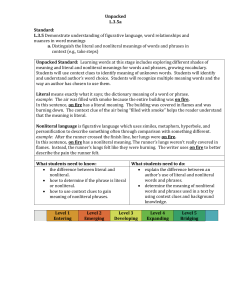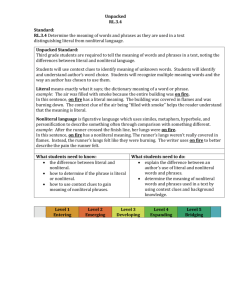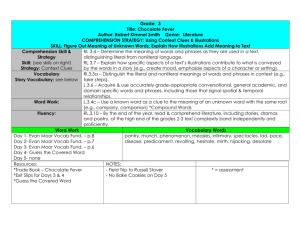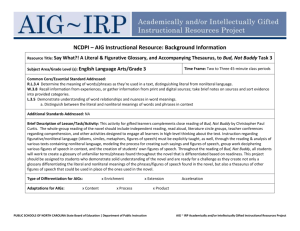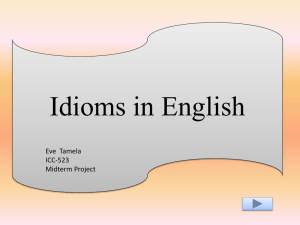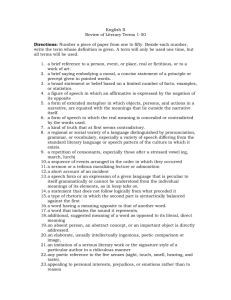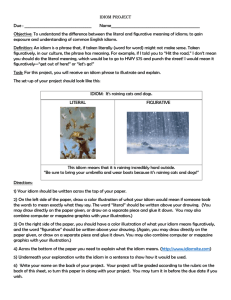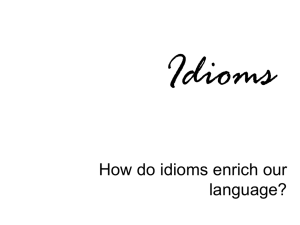Corrine Gaskill Lesson Plan 2 (taught on October 16, 2014
advertisement
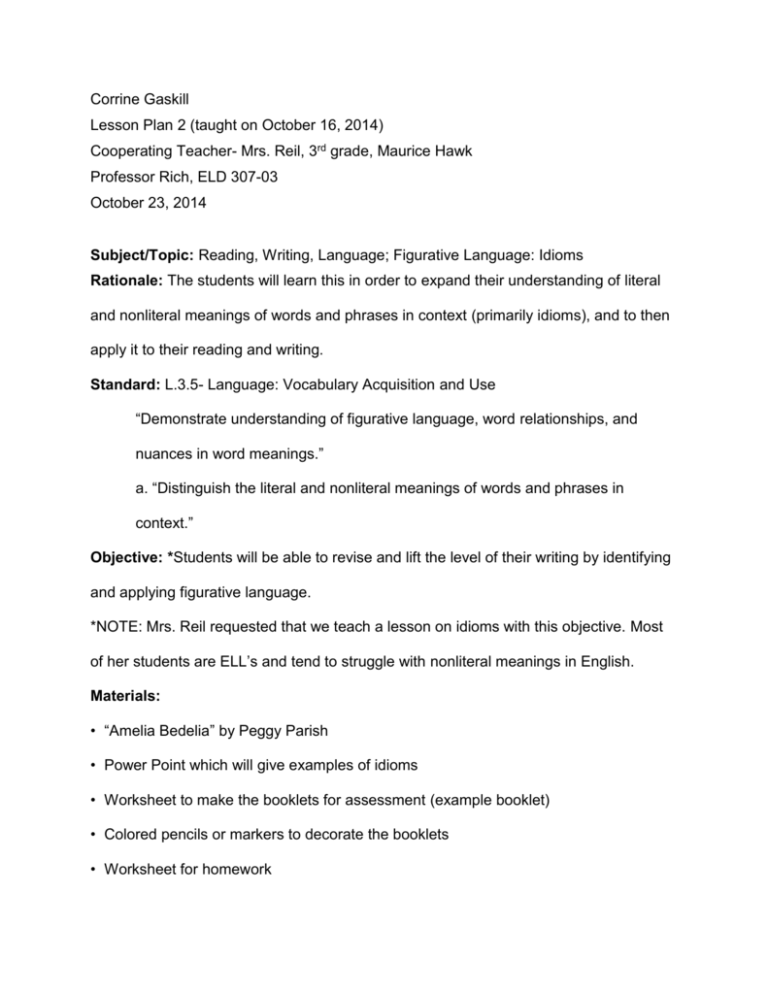
Corrine Gaskill Lesson Plan 2 (taught on October 16, 2014) Cooperating Teacher- Mrs. Reil, 3rd grade, Maurice Hawk Professor Rich, ELD 307-03 October 23, 2014 Subject/Topic: Reading, Writing, Language; Figurative Language: Idioms Rationale: The students will learn this in order to expand their understanding of literal and nonliteral meanings of words and phrases in context (primarily idioms), and to then apply it to their reading and writing. Standard: L.3.5- Language: Vocabulary Acquisition and Use “Demonstrate understanding of figurative language, word relationships, and nuances in word meanings.” a. “Distinguish the literal and nonliteral meanings of words and phrases in context.” Objective: *Students will be able to revise and lift the level of their writing by identifying and applying figurative language. *NOTE: Mrs. Reil requested that we teach a lesson on idioms with this objective. Most of her students are ELL’s and tend to struggle with nonliteral meanings in English. Materials: • “Amelia Bedelia” by Peggy Parish • Power Point which will give examples of idioms • Worksheet to make the booklets for assessment (example booklet) • Colored pencils or markers to decorate the booklets • Worksheet for homework Procedures (with teacher talk): Engagement/Anticipatory Set Begin the lesson by gathering the students at the carpet and preparing to read Amelia Bedelia. The idioms that are in the book are playful and will be used to get their minds thinking about other common ones they probably hear people use. Ask the students, “Has anyone read an Amelia Bedelia book before?” (Student response). “Okay, well today we are going to read this one together because there is a lot of figurative language in it. You have all heard of figurative language, correct? (Student response). I know Mrs. Reil has been prompting you to find it in your book club books. As we read through Amelia Bedelia, pay close attention to see if you can put a name to the type of figurative language we find.” Read the book. “Was anyone able to figure out which type of figurative language this is?” (Student response). If they do not know, tell them we are learning about idioms, and they will get to practice with them. Transition- “Let’s walk back to our desks now so that we can see some examples of commonly used idioms and talk about both their literal and nonliteral meanings.” Mentor/Teach/Model Use the PowerPoint to present the idiom examples and discuss their multiple meanings: “An arm and a leg”– (show picture) the literal meaning is an actual arm and an actual leg. Ask the students if they know what the nonliteral meaning is. The nonliteral meaning behind this phrase is that something costs a lot of money. “Bend over backwards”– (show picture) the literal meaning is to arch your back into a “bridge.” Ask the students if they know what the nonliteral meaning is. The nonliteral meaning behind this phrase is to do everything you can for someone or something. “Bite your tongue”– (show picture) the literal meaning is to actually bite your own tongue, ouch! Ask the students if they know what the nonliteral meaning is. The nonliteral meaning behind this phrase is to tell someone to stop talking. “A piece of cake”– (show picture) the literal meaning is an actual slice of cake. Ask the students if they know what the nonliteral meaning is. The nonliteral meaning behind this phrase is that something is very easy. “Break a leg”– (show picture) the literal meaning is to break a bone in your leg. Ask the students if they know what the nonliteral meaning is. The nonliteral meaning behind this phrase is to wish a performer good luck. “Cry over spilled milk”– (show picture) the literal meaning is to cry whenever you spill milk. Ask the students if they know what the nonliteral meaning is. The nonliteral meaning behind this phrase is to complain or cry about something that is not important. “Hit the books”– (show picture) the literal meaning is to use your hand or another item, such as a hammer, to hit a stack of books. Ask the students if they know what the nonliteral meaning is. The nonliteral meaning behind this phrase is to go do homework or study hard. “Hold your horses”– (show picture) the literal meaning is to wrap your arms around your horses and hold on to them. Ask the students if they know what the nonliteral meaning is. The nonliteral meaning behind this phrase is to be patient or wait your turn. “Get up on the wrong side of the bed”– (show picture) the literal meaning is to wake up and get off of your bed on the side you should not, or to wake up on the side you did not fall asleep on. Ask the students if they know what the nonliteral meaning is. The nonliteral meaning behind this phrase is to wake up in a cranky mood and with a bad attitude. “Raining cats and dogs”– (show picture) the literal meaning is for cats and dogs to be falling from the sky like rain. Ask the students if they know what the nonliteral meaning is. The nonliteral meaning behind this phrase is to say that it is raining really hard, or rather that it is pouring outside. Talk about why idioms are important to use while writing. Ask the class, “So now that we have seen these examples of how idioms are used, why do you think authors use them in their writing?” (Student response). “Why should you use idioms and other types of figurative language in your own writing?” (Student response). Guided Practice/Independent Application Transition- “You want to get some practice first, right, before jumping into revising your independent writings? Here is your chance.” Directions- “You will each get a piece of paper to fold in half ‘hamburger style.’ On the front you will have a box in which to draw a picture of the literal meaning of the idiom you choose.” (Show example idiom booklet). “On the inside, there is a line for you to write your name, one for you to write your idiom phrase, and then the rest of the page to write a short story that includes your idiom. In the short story, make sure you include enough detail so that when others read it, they can tell by the context what the meaning of the idiom is. Please choose your idiom first and write your story before drawing the picture of the literal meaning.” (Hand out worksheets). “If you need help deciding on one, ask for help. If you have time to color the picture when you are finished writing and drawing, please do so. Afterward, you will each get the chance to share with some classmates. Get started!” Walk around and assist any students who need help. Closure Transition- (clap for attention) “I need everyone to pay attention so that you know what to do for our sharing circle.” “Those of you who are even numbers, please come to the carpet with your booklet and stand in a circle, but facing away from each other, which means that all of your backs are facing each other.” (Help them form the circle) “Next, I need the rest of you who are all odd numbers to come to the circle with your booklet and stand around the outside of your classmates, pairing up with one of them. Each person on the inside circle should have a partner from the outside circle.” (Help them pair up if necessary). “Each partner needs to take turns sharing their idiom story, and afterward everyone will get a new partner and get to share again. Thumbs up if you understand.” (Check for understanding). “Okay, go!” (Allow about 1-2 minutes). “I need the outside circle to take three steps counter-clockwise. One…two…three. Okay, stop. Does everyone know who their new partner is, thumbs up?” (Check for understanding). “Okay, go!” (Allow about 1-2 minutes). Finish- (clap for attention). “Everyone turn to face me, please. Does anyone want to share with the class if they learned something new from their partners about why idioms are important to use in your writing?” (Student response). “Great job, everybody! Now, I am leaving you with a challenge: I want to find idioms and other kinds of figurative language you have studied in you personal writings from now on. Take your writing to the next level!” Differentiation: This lesson is differentiated because some students will understand how idioms are used based on the Amelia Bedelia book. Others, though, may need different examples and peer input, which is where the Power Point and discussion comes in to play. Then, for the assessment, the students are not being forced to write about one specific idiom or one specific topic. They each get to choose which idiom they want to use, and they have the freedom to develop any kind of short story. They also have the freedom to draw the literal meaning of their idiom however they would like. Some may be harder to use, while others are simpler, and that is how it is differentiated because they get the choice. Prompting from the teachers will also help them choose one on their level, yet still offer a challenge. Assessment: Their assessment is the project they make in class, which is the idiom booklet. This way, we know that they made it individually and with minor guidance from the teachers. It also shows if they grasped the concept immediately from the lesson. The point is to assess if they could put the correct nonliteral meaning of the idiom in the proper context of their story. Homework They will have to complete a worksheet that has six sentences with blanks for where the idioms are missing. A word bank, or rather an “idiom bank,” is provided for them. They need to decide which idiom belongs in which sentence. The homework is not the assessment because there is no way to truly decipher if a child or parent has completed the homework, even if it is the child’s handwriting.

